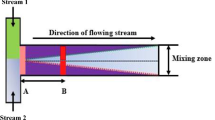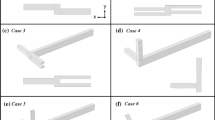Abstract
The development and adoption of lab-on-a-chip and micro-TAS (total analysis system) techniques requires not only the solving of design and manufacturing issues, but also the introduction of reliable and quantitative methods of analysis. In this work, two complementary tools are applied to the study of thermal and solutal transport in liquids. The experimental determination of the concentration of water in a water–methanol mixture and of the temperature of water in a microfluidic T-mixer are achieved by means of fluorescence lifetime imaging microscopy (FLIM). The results are compared to those of finite volume simulations based on tabulated properties and well-established correlations for the fluid properties. The good correlation between experimental and modelled results demonstrate without ambiguity that (1) the T-mixer is an adiabatic system within the conditions, fluids and flow rates used in this study, (2) buoyancy effects influence the mixing of liquids of different densities at moderate flow rates (Reynolds number Re ≪ 10−2), and (3) the combination of FLIM and computational fluid dynamics has the potential to be used to measure the thermal and solutal diffusion coefficients of fluids for a range of temperatures and concentrations in one single experiment. As such, it represents a first step towards the full-field monitoring of both the extent and the kinetics of a chemical reaction.














Similar content being viewed by others
Notes
The experiments carried-out in this work were not performed in a clean room, and microscopic dust particles or fibres often got trapped in the devices. In some cases, as observed here, the flow rate was not high enough to remove them. Although they have little influence on the flow pattern of the global domain, they disturb the local flow velocity enough that their effect is observable through a secondary measurand (temperature or concentration). Some micro-filters and fluid handling procedures are being developed to overcome these disagreements.
References
Abrarall P, Gué AM (2007) Lab-on-chip technologies: making a microfluidic network and coupling it into a complete microsystem—a review. J Micromech Microeng 17:R15–R49
Bennett J, Wiggins C (2003) A computational study of mixing microchannel flows. http://arxivorg/ftp/cond-mat/papers/0307/0307482pdf
Benninger R, Koc Y, Hofmann O, Requejo-Isidro J, Neil M, French P, deMello A (2006) Quantitative 3-D mapping of fluidic temperatures within microchannel networks using fluorescence lifetime imaging. Anal Chem 78:2272–2278
Black M, Sapiro G, Marimont D, Heeger D (1998) Robust anisotropic diffusion. IEEE Trans Image Process 7:421–432
Casey K, Quitevis E (1988) Effect of solvent polarity on non-radiative processes in xanthene dyes: rhodamine B in normal alcohols. J Phys Chem 92:6590–6594
Crank J (1975) The mathematics of diffusion, 2nd edn. Clarendon Press, Oxford
Dougan L, Crain J, Vass H, Magennis S (2004) Probing the liquid-state structure and dynamics of aqueous solutions by fluorescence spectroscopy. J Fluoresc 14:91
Erickson D (2005) Towards numerical prototyping of labs-onchip: modelling for integrated microfluidic devices. Microfluid Nanofluid 1:301–318
Howell PJ, Mott D, Fertig S, Kaplan C, Golden J, Oran E, Ligler F (2005) A microfluidic mixer with grooves placed on the top and bottom of the channel. Lab Chip 5:524–530
Langhaar H (1942) Steady flow in the transition length of a straight tube. J Appl Mech 9:A55–58
Lemmon E, McLinden M, Friend D (2005) Thermophysical properties of fluid systems. In: Linstrom PJ, Mallard WG (eds) NIST chemistry WebBook, NIST standard reference database number 69. National Institute of Standards and Technology, Gaithersburg, p 20899
Lide DR (ed) (2007) Properties of water in the range 0–100°C. In: CRC handbook of chemistry and physics, Internet Version 2007, 87th edn. Taylor & Francis, Boca Raton, FL
Liu Y, Kim B, Sung H (2004) Two-fluid mixing in a microchannel. Int J Heat Fluid Flow 25:986–995
Magennis S, Graham E, Jones AC (2005) Quantitative spatial mapping of mixing in microfluidic systems. Angew Chem Int Ed 44:2–6
Nguyen NT, Wu Z (2005) Micromixers—a review. J Micromech Microeng 15:R1–R16
Ottino J, Wiggins S (2004) Introduction: mixing in microfluidics. Philos Trans R Soc Lond A 362:923–935
Perona P, Malik J (1990) Scale-space and edge detection using anisotropic diffusion. IEEE Trans Pattern Anal Mach Intell 7:629–639
Receveur R, Lindermans F, de Rooij N (2007) Microsystems technologies for implantable applications. J Micromech Microeng 17:R50–R80
Soille P (1999) Morphological image analysis: principles and applications. Springer, Berlin
Stroock A, Dertinger S, Ajdari A, Mezic I, Stone H, Whitesides G (2002a) Chaotic mixer for microchannels. Sci Mag 295:647–651
Stroock A, Dertinger S, Whitesides G, Ajdari A (2002b) Patterning flows using grooved surfaces. Anal Chem 74:5306–5312
Tadmor Z, Gogos C (1979) Principles of polymer processing. Wiley, New York
Wiggins S, Ottino J (2004) Foundations of chaotic mixing. Philos Trans R Soc Lond A 362:937–970
Woolf L (1985) Insights into solute-solute-solvent interactions from transport property measurements with particular reference to methanol-water mixtures and their constituents. Pure Appl Chem 57:1083–1090
Wu Z, Nguyen NT, Huang X (2004) Non-linear diffusive mixing in microchannels: theory and experiments. J Micromech Microeng 14:604–611
Yamaguchi Y, Honda T, Briones M, Yamashita K, Miyazaki M, Nakamura H, Maeda H (2006) Influence of gravity on a laminar flow in a microbioanalysis system. Meas Sci Technol 17:3162–3166
Yoon S, Mitchell M, Choban E, Kenis P (2005) Gravity induced reorientation of the interface between two liquids of different densities flowing larminarly through a microchannel. Lab Chip 5:1259–1263
You YL, Xu W, Tannenbaum A, Kaveh M (1996) Behavioral analysis of anistropic diffusion in image processing. IEEE Trans Image Process 4:1539–1553
Acknowledgments
This research was carried out as part of the “Measurement for Emerging Technologies” programme funded by the National Measurement Systems Directorate of the UK Department of Trade and Industry, and was supported by the EPSRC Insight Faraday Partnership in the form of a studentship for EMG and the SHEFC funding for COSMIC. The authors also wish to acknowledge J. K. Platten and P. G. de Gennes for useful discussions on diffusion models and the measurement of diffusion in fluid systems.
Author information
Authors and Affiliations
Corresponding author
Rights and permissions
About this article
Cite this article
Mendels, DA., Graham, E.M., Magennis, S.W. et al. Quantitative comparison of thermal and solutal transport in a T-mixer by FLIM and CFD. Microfluid Nanofluid 5, 603–617 (2008). https://doi.org/10.1007/s10404-008-0269-5
Received:
Accepted:
Published:
Issue Date:
DOI: https://doi.org/10.1007/s10404-008-0269-5




